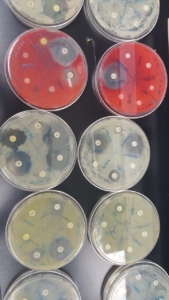Bacterial resistance to antimicrobials and antibiotics is one of the most pressing public-health concerns around the world. Water systems are one of  the major contributors to the spread of resistance, as improperly treated drinking water and wastewater can concentrate antibiotic and antimicrobial compounds while also carrying pathogens to and from human hosts. In the United States, the widespread use of antimicrobial products including soaps, toothpastes, and surfaces as well as the extensive application of antibiotic drugs results in large quantities of these compounds in wastewater treatment systems and aquatic systems. The diverse bacterial communities in wastewater that interact with these compounds in wastewater treatment plants often exhibit resistance to multiple clinically-important antibiotics. Detecting these organisms can be challenging, but it is imperative to understand
the major contributors to the spread of resistance, as improperly treated drinking water and wastewater can concentrate antibiotic and antimicrobial compounds while also carrying pathogens to and from human hosts. In the United States, the widespread use of antimicrobial products including soaps, toothpastes, and surfaces as well as the extensive application of antibiotic drugs results in large quantities of these compounds in wastewater treatment systems and aquatic systems. The diverse bacterial communities in wastewater that interact with these compounds in wastewater treatment plants often exhibit resistance to multiple clinically-important antibiotics. Detecting these organisms can be challenging, but it is imperative to understand

JHU Lab samples
the ability of resistance to change and disseminate in wastewater and in surface waters. In this ongoing research project, samples collected from local wastewater treatment plants and the Chesapeake Bay are being probed for resistance genes and to identify mechanisms of cross-resistance to both antimicrobial and antibiotic compounds. Using trichlosan as a model antimicrobial compound, we are determining if antimicrobial resistance gives rise to antibiotic resistance and vice versa in surface waters.
This project is a collaborative effort at Johns Hopkins University: Dr. Edward Bouwer and Dr. Meghan Davis in the Department of Environmental Health and Engineering (EHE); Dr. Charles Young from the Applied Physics Laboratory; Ms. Hannah Gray, Ph.D. student in EHE.
